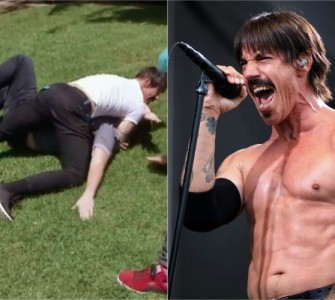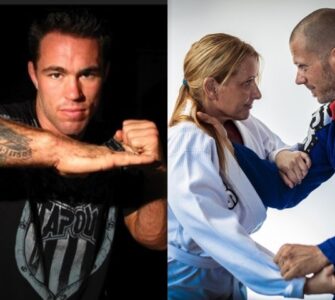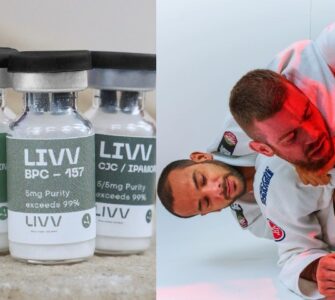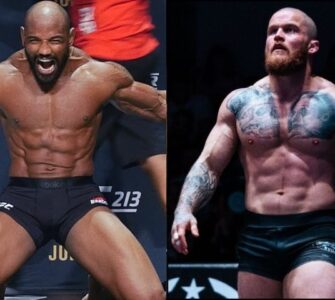“The nature of knowledge is closely linked to the acquisition of knowledge or very simply: what people learn is related to how they learn.“
~Bonni Yordi, “Learning and Social Change: The Formal and the Hidden Curriculum”
As a certified 6th-12th grade high school English teacher, university English professor and karate instructor who studies Brazilian Jiu Jitsu (BJJ), I’m interested in the way BJJ is taught, its methods and curriculum. I’ve noticed that BJJ instruction is special. It is effective for students of all levels, sizes and backgrounds.
BJJ instruction enables success. Why? Because the form (how BJJ is taught) and the content (what BJJ is) harmonize. The art of BJJ comes with a set of values which reinforce cultural norms, expectations of behavior in society. These cultural norms and values can carry over into a student’s life without discord, impacting it in positive ways. Because of the way BJJ is taught, a few years of training can provide invaluable lessons in personal development and communication.
The concept of the hidden curriculum came out of the field of education reform. It can be defined as:
the unwritten, unofficial, and often unintended lessons, values, and perspectives that students learn in school. While the “formal” curriculum consists of the courses, lessons, and learning activities students participate in, as well as the knowledge and skills educators intentionally teach to students, the hidden curriculum consists of the unspoken or implicit academic, social, and cultural messages that are communicated to students while they are in school. (The Glossary of Education Reform)
Essentially, the hidden curriculum encompasses all of the lessons being indirectly taught along with the formal BJJ curriculum. These are the values and behaviors reinforced, modeled or corrected by the professor that lead to success for a BJJ student. For example, when a professor pays careful attention to clear communication in instruction, he is modeling and valuing clarity; when a professor pays attention to detail in technique, he is modeling and valuing conscientiousness; when a professor assigns extended repetitions, he is modeling and valuing mastery; when a professor uses humor in instruction, he is modeling and valuing an awareness of the importance of fun in learning and so on, examples abound. As Bonni Yordi observed, “method and content support a view of the way the world is and ought to be.” The question, then, is this: what worldview are the methods and content of BJJ instruction supporting?
The hidden curriculum, as a concept in education reform, has negative connotations. It is associated with Brazilian educational theorist and activist Paulo Freire who pioneered “critical consciousness.” Freire recognized the ways primary and secondary school hidden curriculums reinforced social inequities while purporting to be equitable, citing their formal curriculums as evidence. Freire was quick to note that the way teachers were teaching, not what they were teaching, was having the effect of limiting some student’s potential. That limiting phenomena would eventually be called the hidden curriculum. BJJ schools seem to be one of the few examples in education where the mission and methods, formal curriculum and hidden curriculum, are in accordance with values that support cultural norms and a healthy worldview.
The BJJ class structure, one part of its hidden curriculum, reinforces important values. For example, the emphasis on choosing partners for drilling and sparring also emphasizes the idea that meeting, and then working efficiently and technically with new people, is a valuable skill. This is in fact an extremely useful social and professional skill.
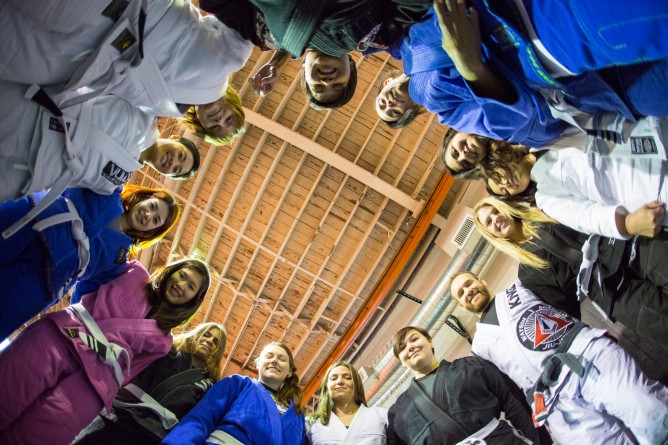
Sparring in class requires self-control. When sparring with partners of varying skill levels, sizes, students need to protect themselves and their partner and dynamically adapt to changing circumstances, underscoring the importance of self-control and awareness. Again, the form and content, the practice and the art, the mission and the values harmonize.
Institutional rules, another part of the hidden curriculum, communicate values as well. In a BJJ school there is emphasis on cleanliness, hygiene and uniform maintenance because BJJ demands that people be comfortable in close contact with others, and uniforms and bodies are as much tools needing to be in operational form as they are needing to be clean.
A student in an excellent BJJ school in which there is concord between the formal and hidden curriculums might reflect, “Not only is what I’m learning good, but how I am learning it is also good” and, in exceptional cases, may also reflect “The people with whom I am learning it are also good to learn with.” This synergy between form and content is rare in formal state education and common in excellent BJJ instruction. Perhaps that is why one works better than the other.
The high expectations of good professors and the physical, intellectual, emotional and cognitive demands of the art of BJJ imply that success is a physical, intellectual, emotional and cognitive endeavor. Formal education tends to focus on the cognitive, neglecting the valuable intellectual, emotional and physical.
Another remarkable aspect of BJJ instruction is the way in which the values of the hidden curriculum are frequently tested and proved useful. In BJJ schools, mastery is valued. Mastery comes from repetition of correct form. Watch a technique being done once and try applying it without mastery, it will not only likely fail, but the student is liable to lose position. There are consequences for sloppiness and haste in applying and learning new techniques. Master a technique and it can be applied naturally, safely and easily. Therefore, mastery as a value is repeatedly championed, tested and proved useful.
Passing a guard without tending to the details will result in frustration and failure, tending to the details (elbows in, posture up, avoid the underhook, carefully address points of resistance, appropriately respond to changing circumstances, etc.) will result in success. Here, again, an abstract value, conscientiousness, is being repeatedly championed, tested and proved useful.
Over time these ways of approaching problems can become ingrained. In their life outside of the gym a student will confront problems requiring skill. The student, knowing that mastery comes from repeated practice of correct form may forego trial and error and focus on mastery first. The lessons learned from the hidden curriculum of BJJ are valuable; trial and error is expensive and mastery always pay dividends.
Feedback in BJJ instruction is also frequent, coming from training partners, reflection and a professor’s correction. In daily life the opportunities to both test and express values are easily missed. On the BJJ mat however, these opportunities are routinely available along with the needed feedback to confirm correct form and reward behavior conducted in accordance with both good BJJ and the values of the institution.
The best BJJ professors teach a formal curriculum that parallels and supports the hidden curriculum. The problem Friere recognized when he uncovered the hidden curriculum was the disconnect between the stated mission and goals of the school and the practices he saw in those schools. For example, at Watson Martial Arts, the motto, the mission, is “The art of improvement.” There is a saying there, I’ll paraphrase, it goes something like this, “If you leave 1% better than you came in you are making progress in the right direction.” Its simplicity is its genius. The goal is to be better and everything students do is oriented toward that difficult and readily achievable goal. High morale is achieved by accomplishing difficult tasks. Improvement is both difficult an achievable making the morale in the gym high, motivating students to find ways to continue to test themselves with the lofty though attainable goal of self improvement. The mission, methods, and content again are in accordance.
I am fortunate to be studying BJJ under professor Kyle Watson at Watson Martial Arts in St. Louis, MO. Professor Watson has a degree in education, extensive business experience outside of running his increasingly successful martial arts academy, is a The Ultimate Fighter (TUF) and Ultimate Fighting Championship (UFC) veteran, and an amazing educator. Professor Watson melds his experience as a BJJ student, coach and competitor, his formal education and his business acumen, bringing those lessons to the gym every day he teaches in the values he communicates. I had the privilege of sitting down with professor Watson to discuss his thoughts on the hidden curriculum, the values communicated through BJJ, and his dynamic student-centered approach to teaching.
During our conversation he explained how he bases his training methods on the feedback he receives from his students and how they respond to his curriculum. He measures success broadly, not only focusing on commitment or attendance, but also on seeing “success in a student’s life, that may be confidence, weight loss, socialization, that may be success in BJJ, high levels of performance, or it may be personal growth and morale, a better demeanor. I see these as equally important measures of an instructor’s success.”
I asked him how he achieves this, “I give the best of BJJ. I see the art as a vehicle for transformation.” Inspiring students to set and meet personal goals is an important part of his teaching, “Student accountability and self-directed learning play a big part in a BJJ student’s growth. I want my students to explore what the art has to offer and to set and reach personal goals.”
I asked him about the kind of curriculum that impresses him, “The schools that impress me develop a curriculum that follows a pattern and addresses multiple channels of learning, multiple learning styles.”
Professor Watson finished our conversation by adding,
“There are so many positive features built into the system, so you can take BJJ and drop it into an atmosphere with a personable, ethical and charismatic instructor and motivated students and you will get alignment between purpose, methods and goals. When you love BJJ and you care about people you will work to use the art to positively impact people’s lives.”
I also had the opportunity to interview one of professor Watson’s senior students, a recent brown belt promotion, new BJJ gym owner and local pastor Steve McKinney. I asked Steve about his experience as a BJJ student and his motivation for pursuing BJJ in middle age, “BJJ was a great way to connect with my son Josh. He was my motivation for starting BJJ.” For Steve, BJJ is about building relationships with people, “Valuing people, valuing training partners as people, you’re not there to tear people up, you’re there to protect them and yourself so they can be there for you. It is really about valuing people, protecting them and protecting yourself. We are all in this together. BJJ is uniting like that.”
Steve sees progress in BJJ as a combination of guided and self-directed learning, “In BJJ progress is measured by the goals you set for yourself and work towards. Metaphorically it is like life, as a student you are using your coach’s wisdom and your goals to help work through barriers. Those little victories keep you going.”
I asked Steve about the kind of instructors that impressed him, “When I first started BJJ I noticed how nice these skilled guys were and they showed a genuine interest in people and they treated people with respect and where excited about teaching people. That impressed me.”
Finally, I asked Steve about the character building effect of BJJ. He explained,
“Absolutely. You get to share your values with people through BJJ. It is a humbling process too. I train with skilled athletes. Younger, stronger, faster competitors like my son Josh (@thejoshmckinney), Adam Marburger and Trevor Ratzky, these guys are tough and as an older BJJ practitioner you have to deal with the situations younger, stronger, faster competitors present you with and sometimes you get tapped and sometimes you tap them and then you have the chance to be a better BJJ practitioner and a better person. BJJ gives me opportunities to share my values with others.”
I am not the only person to notice that BJJ imparts values to students through the curriculum. Chris Matakas has eluded to this phenomena in his insightful and profound reflections on BJJ. Matakas wrote in My Mastery: Learning to Live through Jiu Jitsu, “Determining one’s values is the best way I know to give your life direction” and “In mastering one thing, you have mastered all things because you have learned how to learn” and in his book #Human writes, “I have used my mastery as a vehicle for self-discovery, and the farther I delve into my passions the farther I go into myself.” While Matakas never uses the concept of the hidden curriculum to explain how BJJ helps do these things, clearly he is aware that there is something special about the way BJJ is taught because one does not learn values and introspection from mechanically applying a kimura, one learns values and introspection by how a kimura is taught to be applied.
Why ensure concord between the formal and hidden curriculums? Because good BJJ instruction is good business. Is this unique to BJJ? No, but BJJ instruction, because of its emphasis on efficacy, is special and worth contemplating and understanding if one wants to enrich the experience of learning and teaching BJJ.
*Photos courtesy of Watson Martial Arts
About the Author: David Cormier, PhD, is an adjunct professor of English at Saint Louis University (SLU), a private Jesuit institution in St. Louis MO, he is a karate instructor for the SLU Karate Club in the Cheezic Tang Soo Do Federation under Grand Master Robert Cheezic and a BJJ and Muay Thai student at Watson Martial Arts under Kyle Watson.



